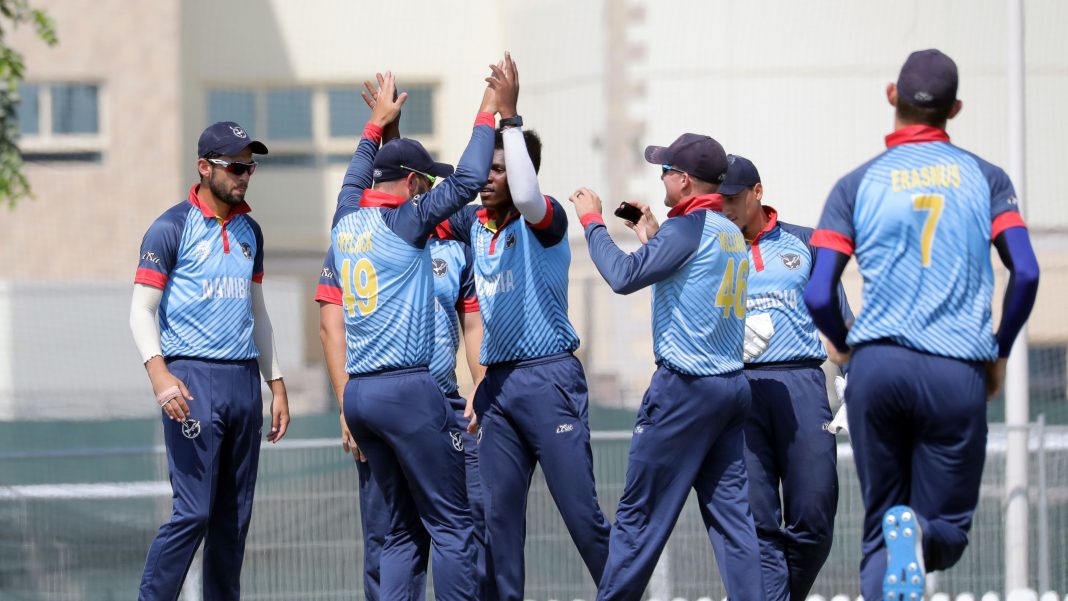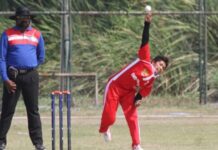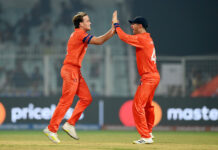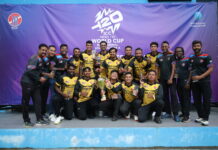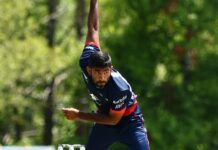Namibia’s squad named this month would shock nobody who has kept an eye on the Eagles in recent times, with a core of ten from the 15-man group that qualified in 2019 and replacements drawn from strong performers over the last few months.
The biggest losses are wicketkeeper-bat JP Kotzé and finger spinner Zhivago Groenewald, who both retired over Namibia’s home season (and both, at 27 and 28 respectively, were arguably in their prime).
Kotzé, a powerful striker and the first Namibian to score a century in both the T20I and ODI formats, hung up his boots in order to spend more time with his young family; Groenewald, an attacking left-armer with 11 wickets in just four ODI appearances, was forced to call it quits by a recurring knee injury. Also shuffled out are seamers Tangeni Lungameni (who failed to impress in his opportunities this year) and Cristi Viljoen (who underwhelmed at the Qualifiers, and has barely played since), while aggressive opening bat Niko Davin fell down the pecking order after an inconsistent outing in Namibia’s domestic Richelieu T20 franchise tournament.
The new faces drafted in are reserve keeper and busy middle-order bat Michau du Preez, exciting young all-rounders Jan-Nicol Loftie-Eaton and Michael van Lingen, tall left-arm fast man Ruben Trumpelmann, and of course the well-publicised inclusion of former Proteas allrounder David Wiese. Up-and-coming off-spinner Mauritius Ngupita also travels as injury cover.
Key players: batting
With both Niko Davin and JP Kotzé out of the picture, wicketkeeper Zane Green staked a convincing claim to the vacant opening slot with 432 runs over the home season (avg. 42.3, SR 151.5). A fluid gloveman who is often selected for his keeping alone, Green’s underwhelming T20I record thus far (79 runs in 11 innings with a strike rate of 101.3) reflects a history of being shunted around the order, but he seems to have found his place as an aggressive pinch-hitter who can provide frenetic starts and doesn’t get bogged down when he fails (in his 11 innings he hit 17 sixes and outpaced the opponents’ run rate 7 times).
The lynchpin of Namibia’s middle-order batting will once again be their captain Gerhard Erasmus. One of the most gifted stroke-players in the emerging game, Erasmus was named Player of the Tournament at the qualifiers in 2019, and his all-round flexibility is unmatched in the squad. Technically sound, strong against spin, capable of rebuilding after early wickets, of rotating the strike in the middle over and of brutal acceleration at the death, he is the ideal number 4.
In the home season this year his returns were modest – from 17 T20 matches played, he only passed 25 five times, and was ahead of the opponents’ run rate in less than half of his innings for a total aggregate of 368 runs at 26.3 and a strike rate of 121.9. He did find convincing ball-striking form though, piling on 507 runs in 50-over format from 9 innings at 72.4 and a strike rate of 103.7 (including two centuries and a pair of 90s). For a player of his class this is doubtless a frustrating aberration, and viewers can expect him to lift on the big stage in October.
Leading the charge at the back end of the innings for the Eagles will be their trump card, and one of the most dynamic players at tournament, the brutally destructive allrounder JJ Smit. Most comfortable swinging the fast men for effortless sixes over long on and long off, he uses his height to generate power all around the ground and is capable of sending anything over the rope if bowlers allow him the slightest margin to free his arms. He was decisive in Namibia’s qualification campaign with 190 runs at 27.1, a tournament-high 14 sixes, and a strike rate of 168.1 (the highest of any batter to pass 100 runs).
In the home season he was unstoppable, belting 38 sixes (an astonishing 17.4% of deliveries he faced) on his way to 445 runs in 12 innings at an average of 63.6 and the eye-watering strike rate of 203.2. In his 12 innings, the only times he fell behind the opposing run rate was in a first-ball duck and a 1* (4) in a comfortable chase. Smit can hit, as the Namibians like to chant in home matches, and if he continues to do so it will go a long way to helping them qualify for the second round.
Key players: bowling
The story of the season for Namibia with the ball was Ruben Trumpelmann, an aggressive left-arm strike bowler who slots in as the spearhead, providing a sharp edge with the new ball that complements their more workmanlike seam options. Qualifying through his Namibian father, Trumpelmann has already played domestically in South Africa, and was the pick of the Namibian bowlers against all comers. Hostile at the top with good speed and a nasty bouncer, he collected 20 wickets in 41.2 overs at 13.3 and 6.5 RPO. In his 12 of his 13 outings, his economy rate was lower than the opposition’s (that is, he kept opposing batters to a lower run rate than Nambia’s). He also contributed handy runs down the order, striking at 146.1 in 5 innings.
Namibia’s spin contingent will be led by Bernard Scholtz, an experienced left arm finger spinner who was crucial to restricting opponents at the qualifiers with 15 wickets a 5.3 economy rate. Relying more on subtle variations and unerring accuracy than extravagant turn, Scholtz is an artist of the miserly – in 99 official T20s for Namibia he has 109 wickets at a shade over 6 RPO, and he can be expected to effectively tie down an end during the middle overs. Over the Namibian T20 season he sent down 36.5 overs at 6.5 RPO, collecting 13 wickets at 18.5. In his 14 innings with the ball, he conceded runs at a lower rate than the opposition 11 times.
X-factor: eyes on David Wiese
The name on the team sheet that has attracted the most attention for Namibia is ex-South Africa allrounder David Wiese.
A T20 franchise journeyman with a Namibian father and well over 250 matches of experience, he brings hard-hitting acceleration down the order (especially if the fast men offer any width) along with the wicket-taking potential of his bag of right-arm seamer’s tricks; both were on show in his player-of-the-match performance in the recent CPL semi-final, where he propelled the St. Lucia Kings into the decider with 34* (21) and 5/39.
Where Erasmus and de Bruyn choose to slot him into this Namibian XI will be an interesting subplot, but he may well be deployed first change with the ball (offering some variety to the flotilla of left-armers) and after JJ Smit with the bat.
Tournament prospects
Namibia, drawn into Group A alongside Ireland, the Netherlands and Sri Lanka, face arguably the tougher of the two First Round groups, and will certainly need to be at their best to qualify to the main stage of competition. If they can iron out their lineup though, and integrate the talents of David Wiese, they are in with a good chance of not just progressing, but of springing an upset or two in the Super Twelves phase.
Aggression at the top of the order, experienced heads to consolidate or rebuild, a world-class bat holding it together in the middle, and one of the most explosive finishers in the Associate game – if Namibia’s batting clicks it will be a threat to any bowling attack. Add in a strong tail capable of clearing the rope at the death and it gives the Eagles the depth to go hard through the whole 20 overs.
A revamped seam attack with a plethora of spin options offers tactically astute skipper Gerhard Erasmus all the tools necessary to restrict the opposition and make it through the “group of death”. In their first appearance at a global event in a generation, Namibia should be confident in their ability to rise to the challenge.
Best XI (predicted): Zane Green (wk), Stephan Baard, Craig Williams, Gerhard Erasmus (c), Michael van Lingen/Jan-Nicol Loftie-Eaton, JJ Smit, David Wiese, Jan Frylinck, Pikky Ya France/Ben Shikongo, Ruben Trumpelmann, Bernard Scholtz.
Full squad: Gerhard Erasmus (captain, RHB/RAO), JJ Smit (vice-captain, LAMF/RHB), Jan Frylinck (LAMF/LHB), Karl Birkenstock (LHB/RAM), Ben Shikongo (RAMF/RHB), Bernard Scholtz (LAO/RHB), Nicol Loftie Eaton (LHB/RALS), Craig Williams (RHB/RAMF), Michael van Lingen (LHB/LAM), Stephen Baard (RHB), Ruben Trumpelmann (LAF/RHB), Zane Green (WK/RHB), David Wiese (RAMF/RHB), Pikky Ya France (RAOS/RHB), Michau du Preez (WK/RHB), Mauritius Ngupita (reserve player, RAOS/RHB).
You’re reading Emerging Cricket — brought to you by a passionate group of volunteers with a vision for cricket to be a truly global sport, and a mission to inspire passion to grow the game.
Be sure to check out our homepage for all the latest news, please subscribe for regular updates, and follow EC on Twitter, Facebook, LinkedIn and YouTube.
Don’t know where to start? Check out our features list, country profiles, and subscribe to our podcast.
Support us from US$2 a month — and get exclusive benefits, by becoming an EC Patron.

